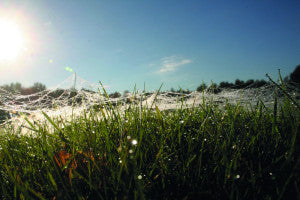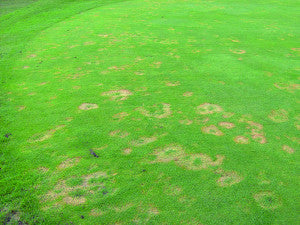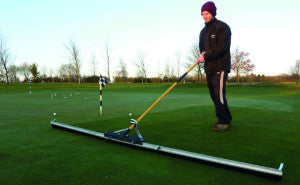Identifying disease problems

Recently, we have seen evening air temperatures dropping dramatically, especially when we have clear cloudless nights, resulting in heavy morning dews on our playing surfaces.
Dew forms when a surface cools to a temperature which is colder than the air next to the surface. Dew is water that has condensed from some of the water vapour contained in the air. If the layer of air next to the ground were actually cooling, then fog would form. Instead, it is just the surface (for instance, grass) that is cooling, and a very thin layer of air next to the grass deposits some of its water vapour on the grass.
The combination of early morning dews, warm and wet weather and diminishing daylight hours increases the risk of fungal disease outbreaks. The right conditions to trigger these disease attacks are weakened or susceptible plants, a disease-producing organism (pathogen usually fungi) and weather conditions which favour the formation of fruiting bodies and spores (moist, mild wet conditions).
Most cool season turfgrass diseases spread via water droplets. Plants also release excess nutrients via their stomatas (gutation) during night hours when there is no sun and rarely any wind to evaporate it. These exudates become mixed with the dew water and become the perfect food source for disease pathogens in their early stages of development.
The majority of diseases that are occurring now have responded to the unusually warm, autumn weather conditions. Boundary layers around the leaves have stayed very moist and humid. Relative humidity is important for spore germination and penetration of leaf tissues, and constant wet conditions will allow the development and transportation of active fungi spores.
Most fungi grow well between 10°C - 40°C and function best at a pH range of 4-7pH. The current lack of cooler weather and sharp frosts has not helped in reducing these active pathogens.
The first step in turfgrass disease management is identifying the true nature of the problem. Diseases are only one cause of turf loss, and disease control measures will do nothing to alleviate damage from other causes such as management, wear or plant stress. It is therefore essential to determine whether the problem is disease, and if so, which disease.
The three disease factors: susceptible grass / host, pathogen, and environment, provide the evidence for disease diagnosis. Symptoms are the expression of the susceptible grass to the disease and can take on a variety of forms.
Symptoms may appear on the leaves as small, circular, tan-coloured lesions surrounded by brown or purple borders (leaf spotting); as yellow, red, or tan blotches over most or all of the leaf blade (blighting); stunting; wilting; or as a brown or black rot on the crowns and roots. The appearance of these symptoms will also vary depending on the type of disease, the severity of the attack and the developing stage of the disease.
Early identification of the

Over the years, we've developed many methods of removing dew from playing surfaces, from dragging hose pipes over pitches to switch canes on bowling and golf greens. However, these laborious tasks have been superseded with the development of brushing attachments that can be fitted to both mowers and gators to speed up operations, though hand switching also gives you an opportunity to get close and personal and keep an eye on what's happening.
Other cultural methods to help reduce disease pressure would be removal of thatch, which harbours pathogens, by verti-cutting and end of season renovations, as well as checking mower blades are sharp to provide a precise cut of the leaf blade and reduce the potential for disease.
Identification of these diseases can sometimes be difficult in the early stages of attack. It's often only possible to recognise the type of disease when the fruiting bodies of the disease produce structures such as spores, mushrooms, or mycelium (small, thread-like filaments produced by fungi) that can be seen without the aid of a microscope. A good example of this is Red Thread (Laetisaria fuciformis) where the distinctive red filaments can be seen amongst the grass.
Site characteristics and turf management practices have a large influence on disease management. Factors such as air movement, drainage, soil conditions, and the amount of sun or shade, slope, fertilisation and aeration programmes are important in influencing the development of turf diseases.
It is important to remember that pathogenic fungi can survive and remain in a dormant state in plant debris and soil until favourable conditions arrive again to stimulate another disease outbreak.
The pathogens that cause these diseases are always lying dormant, waiting for the ideal conditions to become active. Once these spores are activated, and have found an appropriate host, they are able to grow and reproduce themselves, spreading new spores and infections to other areas of turf. This cycle continues whilst favourable conditions prevail.
Understanding and implementing works that can break up the disease cycle will help reduce the opportunities for disease development and outbreak.

It is also important for the lab to be able to see what the general composition and condition of the sward is like and what the rootzone profile is like and, for those reasons, a 90mm diameter core sample, taken to a depth of approximately 60mm using a golf hole changer (or similar) makes for an ideal sample.
If possible, email photographs of the symptoms so that the lab can get an idea of how the problem is developing - a good picture can often tell so much more than a detailed written description.
There are a number of excellent laboratories that offer disease recognition, along with some good weather services that offer disease watch forecasts. One we recommend is Syngenta's Greencast service.
Common diseases that can be active and cause concerns at this time of the year are: Red Thread, Fusarium and Dollar Spot.
It is important to have identified the disease correctly, so that an appropriate fungicide can be selected. Using the wrong fungicide or wrong application rates can lead to a number of problems, not only would it be a waste of time and money, the effect on the disease is likely to be negative and may well exacerbate the problem by making the disease more resilient to the active ingredient applied.
Author: Laurence Gale, Pitchcare Editor
